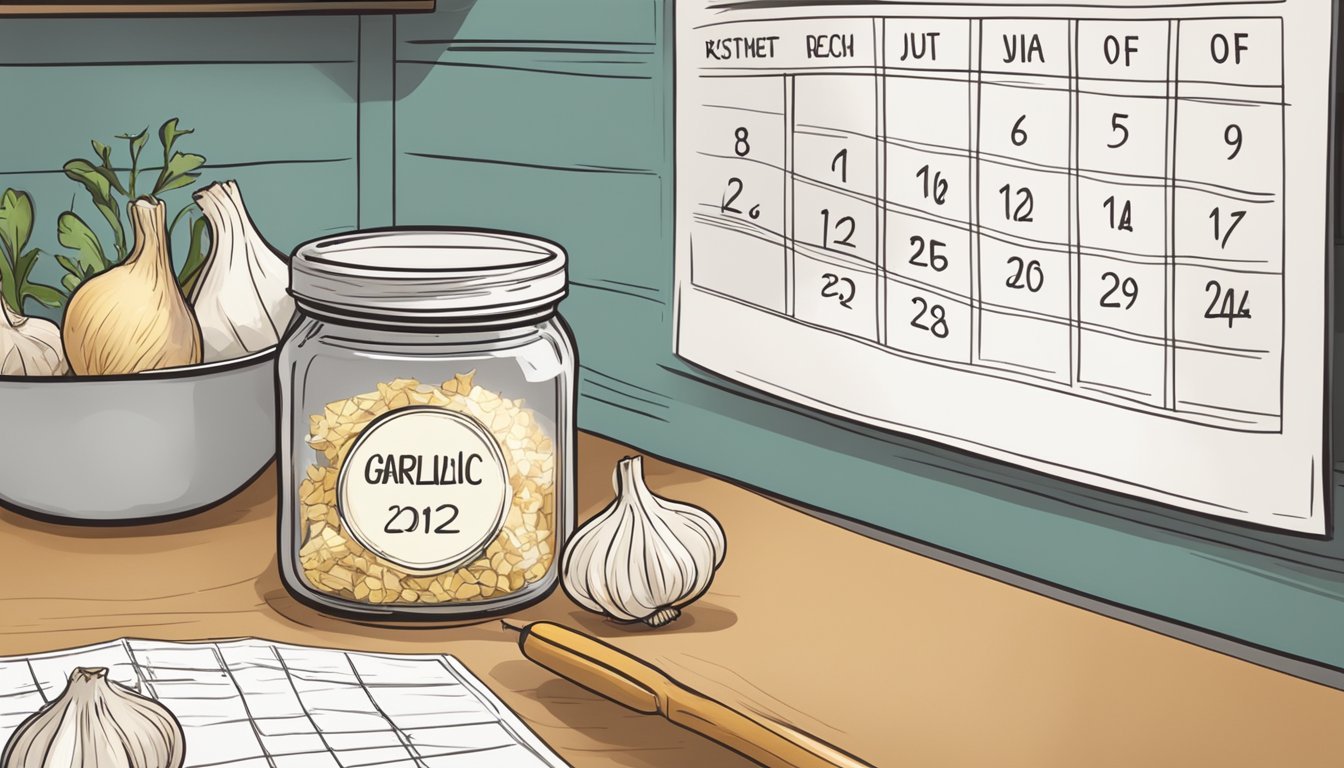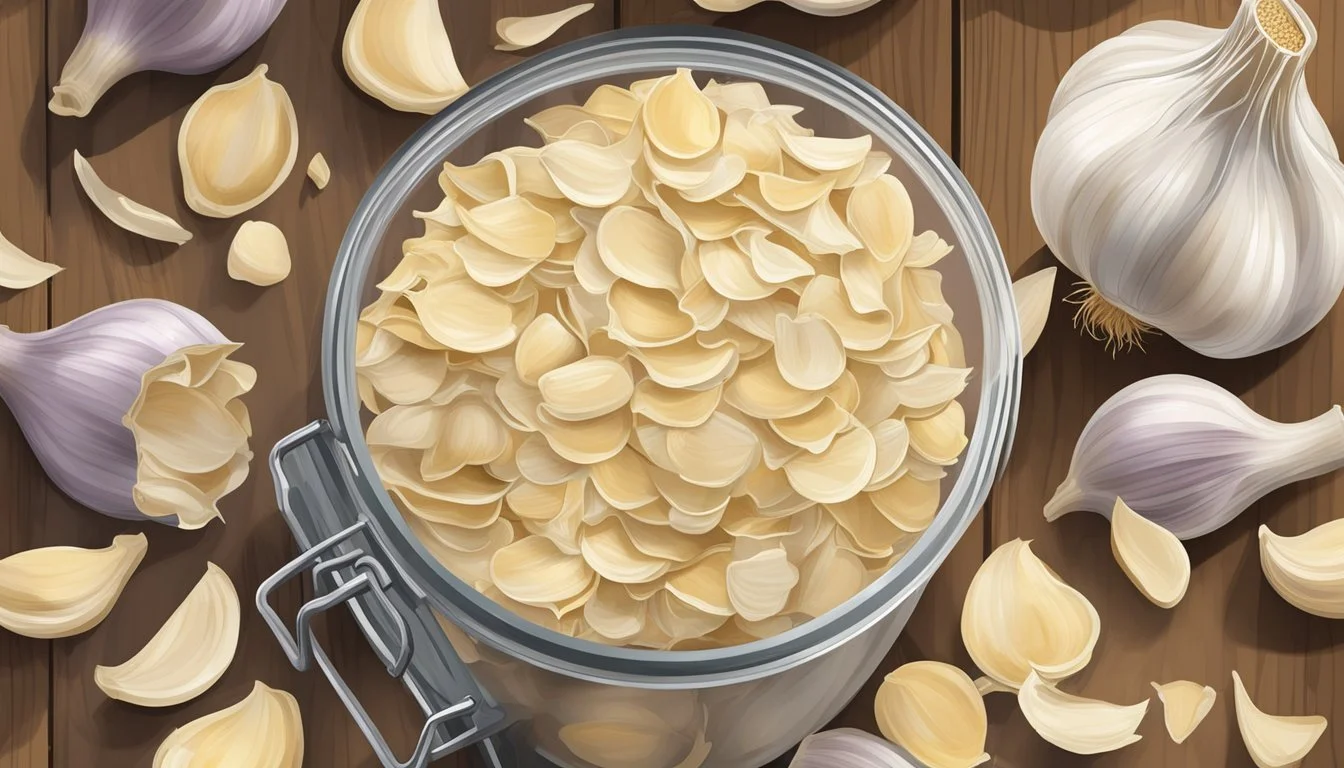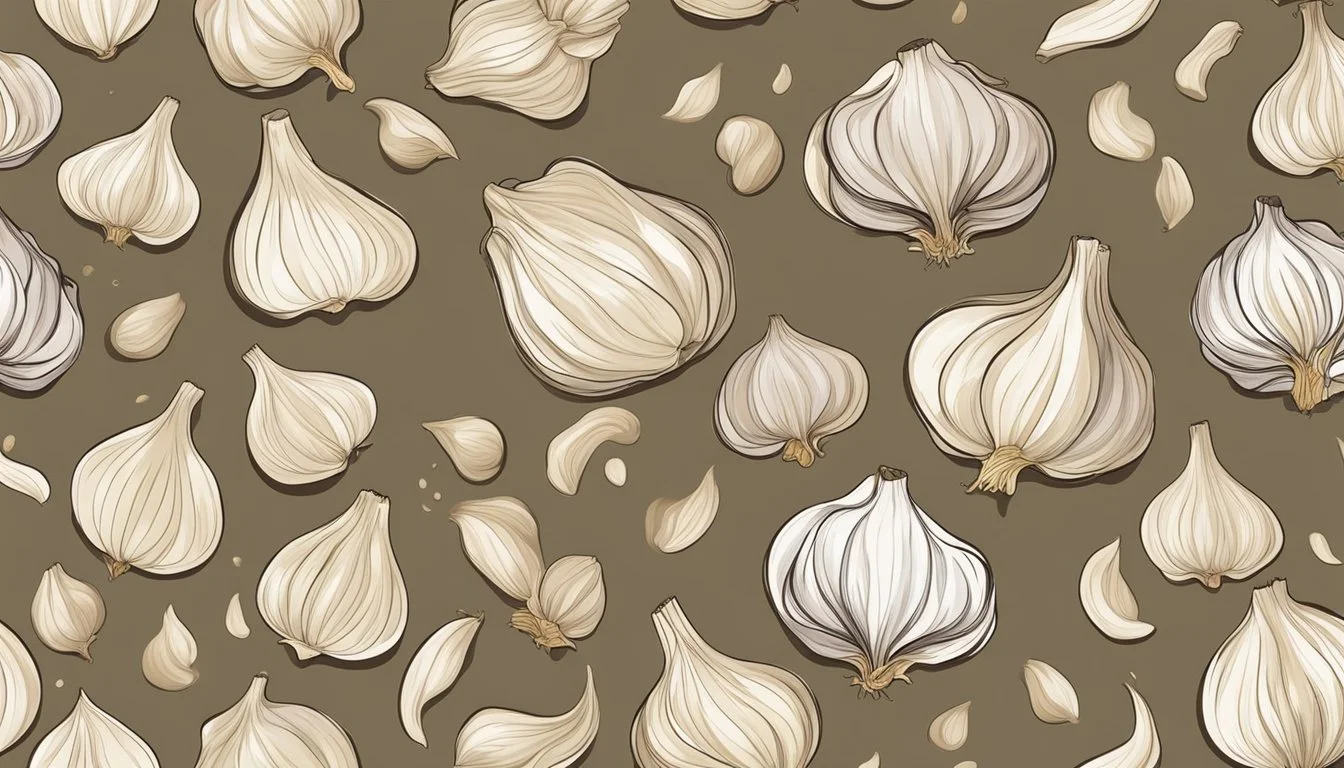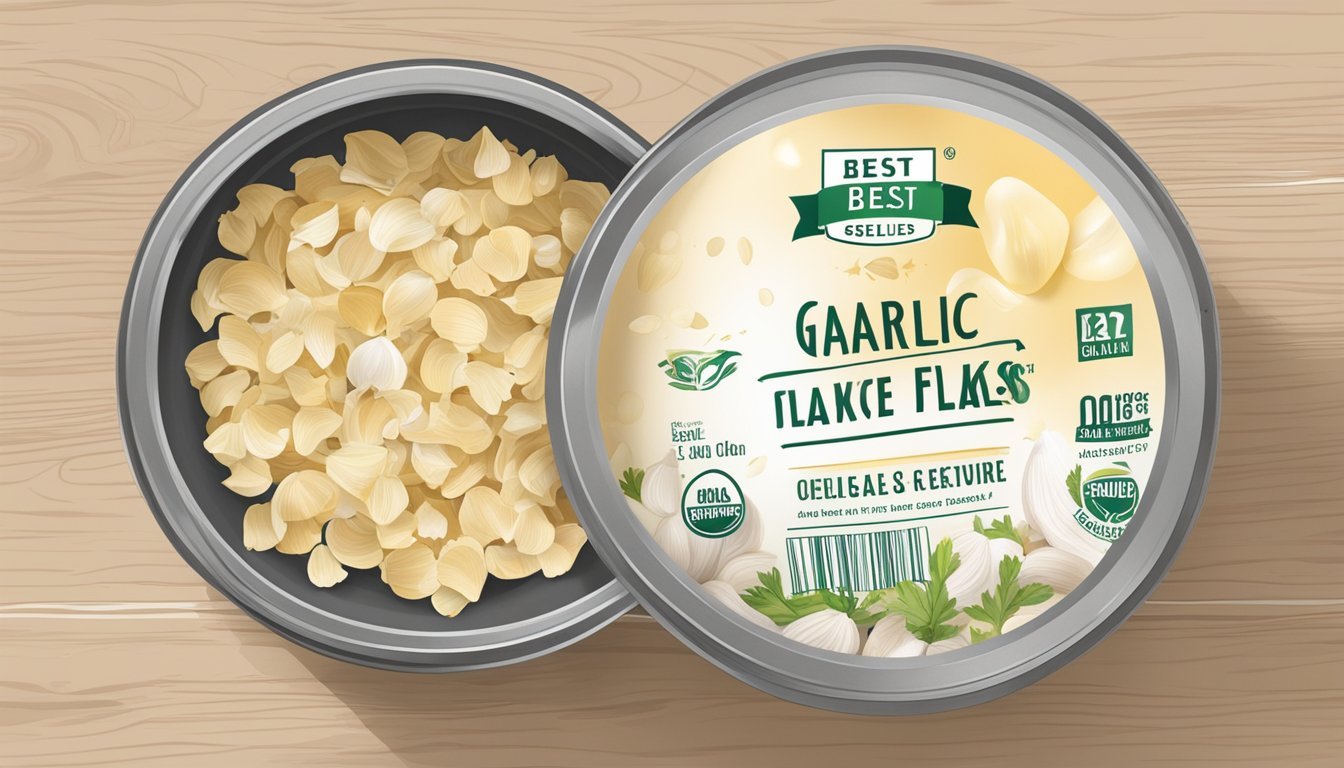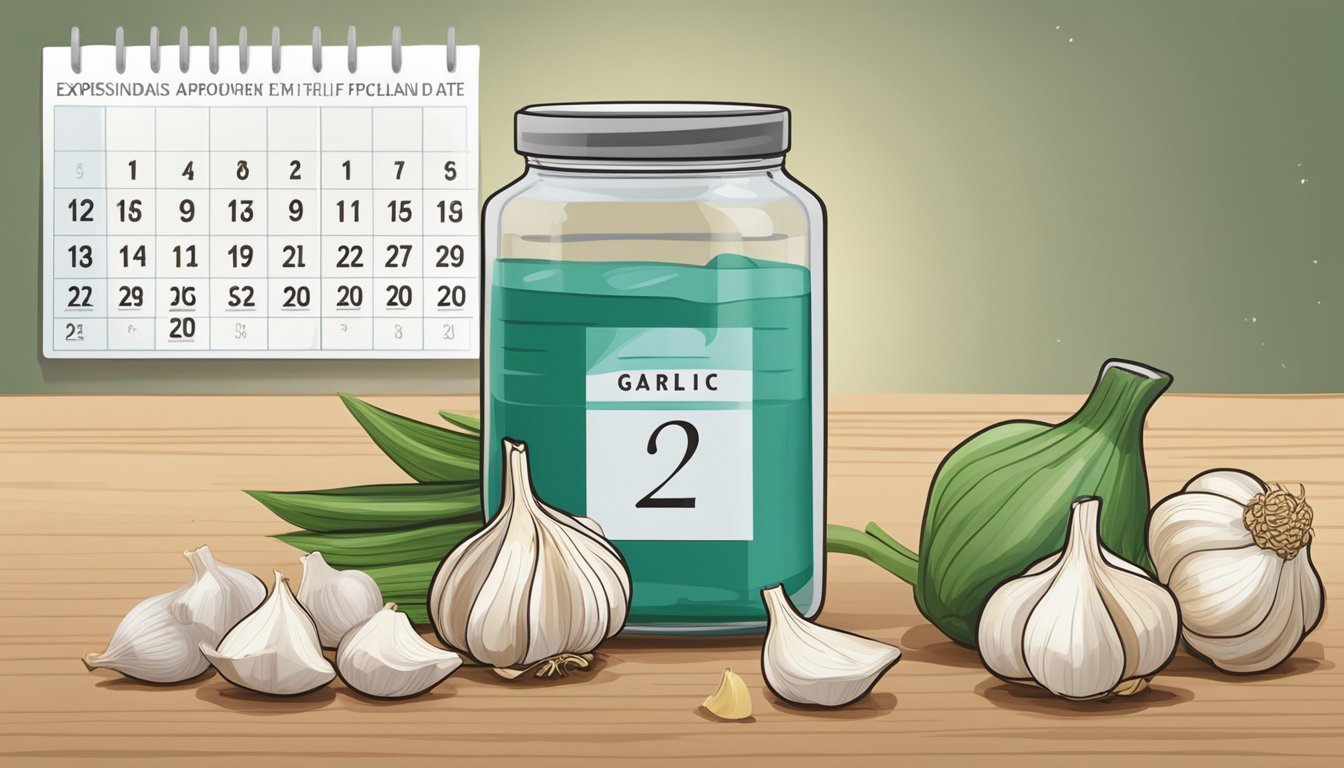How Long Do Garlic Flakes Last?
Shelf Life and Storage Tips
Garlic (What wine goes well with garlic?) flakes are a popular and convenient alternative to fresh garlic, offering a long shelf life and concentrated flavor that enhances a variety of dishes. These dehydrated slices of garlic retain many of the same nutritional benefits and culinary uses as their fresh counterparts but have the added benefit of a considerably extended shelf life when stored properly. Utilizing garlic flakes can add a milder, less pungent taste to slow-cooked meals (how long do cooked meals last?), making them a staple in the pantry of home cooks and professional chefs alike.
The key to maximizing the longevity and preserving the quality of garlic flakes is proper storage. To maintain their flavor and nutrient content, garlic flakes should be kept in an airtight container in a cool, dry, and dark location. Exposing the flakes to heat and light can lead to a loss of potency, sprouting, or mold. When stored under optimal conditions, garlic flakes can last for up to 12 months, ensuring they are readily available to enrich the flavor profile of various dishes throughout the year.
Understanding Garlic Flakes
Garlic flakes are made from fresh garlic bulbs that are carefully dehydrated. They are favored for their long shelf life, ease of storage, and ability to retain much of their original flavor and aroma. These dehydrated bits of garlic are versatile and can be used in a multitude of dishes where the flavor of garlic is desired without the moisture of fresh garlic.
The dehydration process involves slicing or mincing garlic cloves into uniform pieces. These pieces are then dried until their moisture content is significantly reduced, giving them a crisp texture. Garlic flakes offer a milder flavor compared to fresh garlic, which makes them suitable for dishes that require a subtle garlic undertone without overpowering other ingredients.
Flavor: While garlic flakes preserve the garlic's essential taste, they are less pungent than their fresh counterparts.
Texture: They have a dry, crunchy consistency that rehydrates when added to wet ingredients.
Aroma: Garlic flakes maintain a good portion of the garlic's natural scent, enriching dishes with their characteristic smell.
Use: They can be used directly in recipes or rehydrated by soaking in water.
In terms of storage, garlic flakes must be kept in an airtight container in a cool, dry, and dark location to maintain their quality. Exposure to heat, light, or moisture will diminish their flavor and could lead to spoilage. Proper storage is essential for preserving their desired qualities for extended periods.
Shelf Life of Garlic Flakes
Garlic flakes, which are dehydrated slices of garlic, offer a convenient way to store and use garlic. Their shelf life is notably longer than that of fresh garlic, due to the removal of moisture which inhibits bacterial growth and mold. Properly stored garlic flakes typically last up to 12 months while maintaining quality and flavor.
Storage Tips:
Keep garlic flakes in an airtight container to preserve freshness.
Store them in a cool, dry place away from direct sunlight.
Moisture can significantly decrease the longevity of garlic flakes, hence avoid exposure to water.
Signs of spoilage in garlic flakes include:
A noticeable change in color.
Loss of aroma; a sharp, pungent smell indicates good quality.
The presence of mold or moisture in the container.
When stored optimally, garlic flakes keep their quality for an extended period, though it's best to use them within a year. The flavor of garlic flakes might gradually diminish over time, so they should be checked periodically to ensure they retain the desired taste and potency. For those looking to extend the shelf life further, garlic flakes can be stored in the freezer, which can help maintain their quality for an extended duration.
Factors Affecting Longevity
The longevity of garlic flakes is influenced by several factors, such as storage conditions and preparation methods. These factors are crucial in determining how long the garlic flakes will stay potent and safe for consumption.
Storage Conditions
Garlic flakes should be stored in a cool, dark place to maintain their quality. A pantry or cupboard away from any heat sources is ideal. The key is to minimize exposure to elements that can degrade their flavor and structure, such as moisture and excessive air circulation.
Moisture: Keep garlic flakes in an airtight container to prevent moisture from seeping in as it leads to clumping and potential mold growth.
Humidity: Areas with low humidity are preferable since high humidity can spoil garlic flakes quicker.
Air Circulation: Good air circulation helps in preserving the flakes' longevity but excessive exposure to air can hasten the loss of their aromatic oils.
Temperature and Light
Temperature and light have a significant impact on the shelf life of garlic flakes. To ensure maximum longevity:
Temperature: Store them at room temperature, ideally between 60-65°F (15-18°C).
Direct Sunlight: Keep the garlic flakes away from direct sunlight as it can raise the temperature and cause the flavor to diminish more rapidly.
Garlic Preparation
The preparation of garlic prior to drying it into flakes affects its shelf life.
Clove: Whole garlic cloves, when dried, can last longer than those that are pre-processed into smaller pieces.
Minced, Peeled, Chopped Garlic: These forms of garlic, when dried, are more exposed to oxidization and degradation, which can reduce the shelf life of the resulting flakes compared to those made from whole cloves.
Dried Garlic: Properly dried, dehydrated garlic will last considerably longer than fresh garlic preparations.
Granulated Garlic: Similar to garlic flakes, granulated garlic's longevity benefits from similar storage conditions — cool, dark, and dry.
Optimal Storage Methods
When storing garlic flakes, one must ensure that the methods applied are conducive to preserving their freshness and flavor. Employing the correct storage techniques extends the shelf life of garlic flakes.
Firstly, one should use an airtight container to store garlic flakes. This type of container prevents moisture from getting in and flavor from getting out, which is essential to maintain the quality of the flakes. Materials like glass or metal are ideal for this purpose.
To further protect garlic flakes from quality degradation, they should be placed in a cool, dry location such as a pantry. Direct sunlight and high temperatures can compromise the integrity of garlic flakes, so the chosen storage area should be away from any heat sources like ovens or stovetops.
For individuals who do not have an airtight container, alternative storage solutions include paper bags or mesh bags. These materials allow for air circulation, which is crucial in preventing moisture retention that could lead to spoilage. However, one must note that fla:
Avoid plastic bags as they trap moisture and can hasten the degradation process.
Regularly check the storage area to ensure it remains dry and at a consistent temperature.
Through proper storage methods, one can significantly extend the shelf life of garlic flakes, ensuring they remain a flavorful and aromatic addition to dishes for a longer period.
Signs of Spoilage
When examining garlic flakes for freshness, one should consider visual, olfactory, and textural indications of spoilage. Detecting these signs early ensures the garlic is used when its flavor and safety are at their peak.
Visual Indicators
Garlic flakes should typically maintain a light cream to pale yellow color. Discoloration is a primary sign of deterioration. Specific visual signs to look out for include:
Brown or Dark Spots: May indicate the presence of mold or the onset of decay.
Green Sprouts or Roots: Although not harmful, they suggest the garlic is past its prime and flavor may be altered.
It’s prudent to inspect garlic flakes closely for any unusual changes in color as this often precedes additional signs of spoilage.
Olfactory Cues
Fresh garlic flakes should possess a characteristic aromatic smell, attributed to the sulfur compounds within. However, changes in aroma can signal spoilage:
An offensive or overly pungent smell is a clear indicator the garlic is no longer suitable for consumption.
A lack of distinct garlic aroma may suggest the flakes have lost their potency and are stale.
Texture Changes
The ideal texture of garlic flakes is dry and crisp. Any deviation from this can indicate the product is compromised:
Softness or Stickiness: Moisture may have penetrated the flakes, making them susceptible to mold.
Excessive Dryness or Brittleness: While garlic flakes are dry by nature, if they crumble to dust easily, they may be too old and have lost their flavor.
Monitoring these aspects closely will ensure the garlic flakes are used when they offer the most culinary benefit and pose no health risks.
Safety Considerations
When storing garlic flakes, safety is paramount. Garlic, in the right conditions, is susceptible to botulism, particularly if it's stored in oil. However, garlic flakes typically have a low moisture content, reducing the risk of botulism when stored correctly.
Mold can thrive in moist environments. If garlic flakes are exposed to high humidity or water, they may become a breeding ground for mold. Ingesting moldy garlic can lead to foodborne illnesses. To mitigate this risk, one should store garlic flakes in a cool, dry environment.
Spoiled garlic is often identifiable by its off smell and discoloration. If garlic flakes have a sharp, unpleasant odor or exhibit visible growth or color changes, they should be discarded immediately. This is not just a quality concern; it is a safety issue.
Regarding food storage, garlic flakes should be kept in an airtight container to prevent moisture and other contaminants from entering. Below is a table summarizing the do's and don'ts of storing garlic flakes:
Do's Don'ts Store in airtight containers. Expose to moisture or high humidity. Keep in a cool, dry, dark place. Store near heat sources or in direct sun. Discard if odor or mold is present. Use if there are signs of spoilage.
By adhering to these safety considerations, consumers can ensure their garlic flakes remain a flavorful and safe addition to their culinary repertoire.
Extending Shelf Life
To maximize the longevity of garlic flakes, proper storage methods are essential. By managing temperature and preservation techniques, one can significantly extend the shelf life of garlic flakes beyond their typical pantry duration.
Freezing Garlic
Freezing garlic flakes is an effective method to prolong their shelf life. When stored appropriately in the freezer, garlic flakes maintain their quality for several months. It is crucial to utilize an airtight container or a sealed plastic bag to prevent moisture and freezer burn.
Peeled garlic cloves: If one opts to freeze whole cloves, ensure they are peeled and placed in a single layer on a baking sheet before transferring to a container. This prevents them from clumping together.
Garlic powder (how long does garlic powder last?) and garlic salt: These variants also benefit from freezer storage, as the cold environment helps maintain their flavor potency.
Preservation Techniques
Aside from freezing, several other preservation techniques are available to retain the quality of garlic flakes.
Dehydrating: Garlic can be sliced thin, dehydrated at 115°F (46°C) until thoroughly dry, and then stored in an airtight container away from direct sunlight.
Method Instructions Storage Dehydration Dehydrate at 115°F for 6-8 hours or until dry Airtight container, cool place
Pickling: Garlic scapes and cloves can be pickled, which involves immersing them in a vinegar-based solution. This method not only preserves the garlic but also imparts a unique flavor.
Method Instructions Storage Pickling Immerse in vinegar solution Refrigerator, sealed container
By implementing these techniques, one can ensure that their garlic flakes remain flavorful and suitable for culinary use for an extended period.
Culinary Uses of Garlic Flakes
Garlic flakes, dehydrated slices of garlic, are versatile in the kitchen. They add a milder garlic flavor to dishes compared to fresh cloves. Here is a breakdown of their culinary applications:
Cooking: Chefs incorporate garlic flakes into slow-cooked dishes. The flakes gradually rehydrate and impart their flavor without overpowering the recipe.
Seasoning: They serve as an alternative to garlic powder for seasoning proteins such as chicken, beef, or tofu.
Vegetable and Salad Preparation: Garlic flakes can be tossed with vegetables before roasting or sprinkled on salads for an extra flavor dimension.
Dressing: When making dressings, garlic flakes are an ideal choice as they blend well with liquids and provide a subtle garlic undertone.
Their use is not just limited to savory dishes; garlic flakes are also common in:
Garlic Bread: For homemade garlic bread, garlic flakes offer a more textural and visually appealing option than other garlic forms.
Pesto: Some pesto recipes call for garlic flakes to achieve layers of flavors without an intense garlic punch.
Utilizing garlic flakes yields meals with nuanced garlic notes suitable for various palates. Chefs value them for the convenience and longevity they bring to the pantry.
Alternative Garlic Products
When fresh garlic is not available or practical, there are several processed garlic products that can serve as suitable replacements. It's important to note the potency and flavor profile differences when using these alternatives.
Garlic Powder: This is dried garlic that has been finely ground. It's mild compared to fresh garlic and is ideal for even distribution in dishes like rubs and marinades.
Garlic Salt: A blend of garlic powder and salt, garlic salt simplifies seasoning but should be used cautiously to prevent over-salting a dish.
Granulated Garlic: Coarser than garlic powder, granulated garlic is a good all-purpose option, providing texture and flavor without the moisture of fresh garlic.
Minced Garlic: Usually found jarred in oil or water, minced garlic offers a convenience factor, with a small amount packing a powerful punch.
Chopped Garlic: This is larger than minced garlic and can be found in oil-packed jars. Its flavor is less intense, making it suitable for sautés and stews where it can impart a subtle garlic note.
Garlic Oil: Infused with garlic flavor, garlic oil is used to add a hint of garlic to dressings, dips, and as a finishing oil.
Garlic Keeper: Not a garlic product but a storage container designed to keep garlic cloves fresh for longer by protecting them from light and moisture.
Garlic Scapes: These are the flower stalks of garlic plants. They have a milder flavor than the garlic cloves and can be used in similar ways to green onions.
While each of these products can substitute for fresh garlic, their flavors and uses vary and should be chosen based on the requirements of the recipe and desired outcome.


